Biermann Ch. Handbook of Pulping and Papermaking
Подождите немного. Документ загружается.

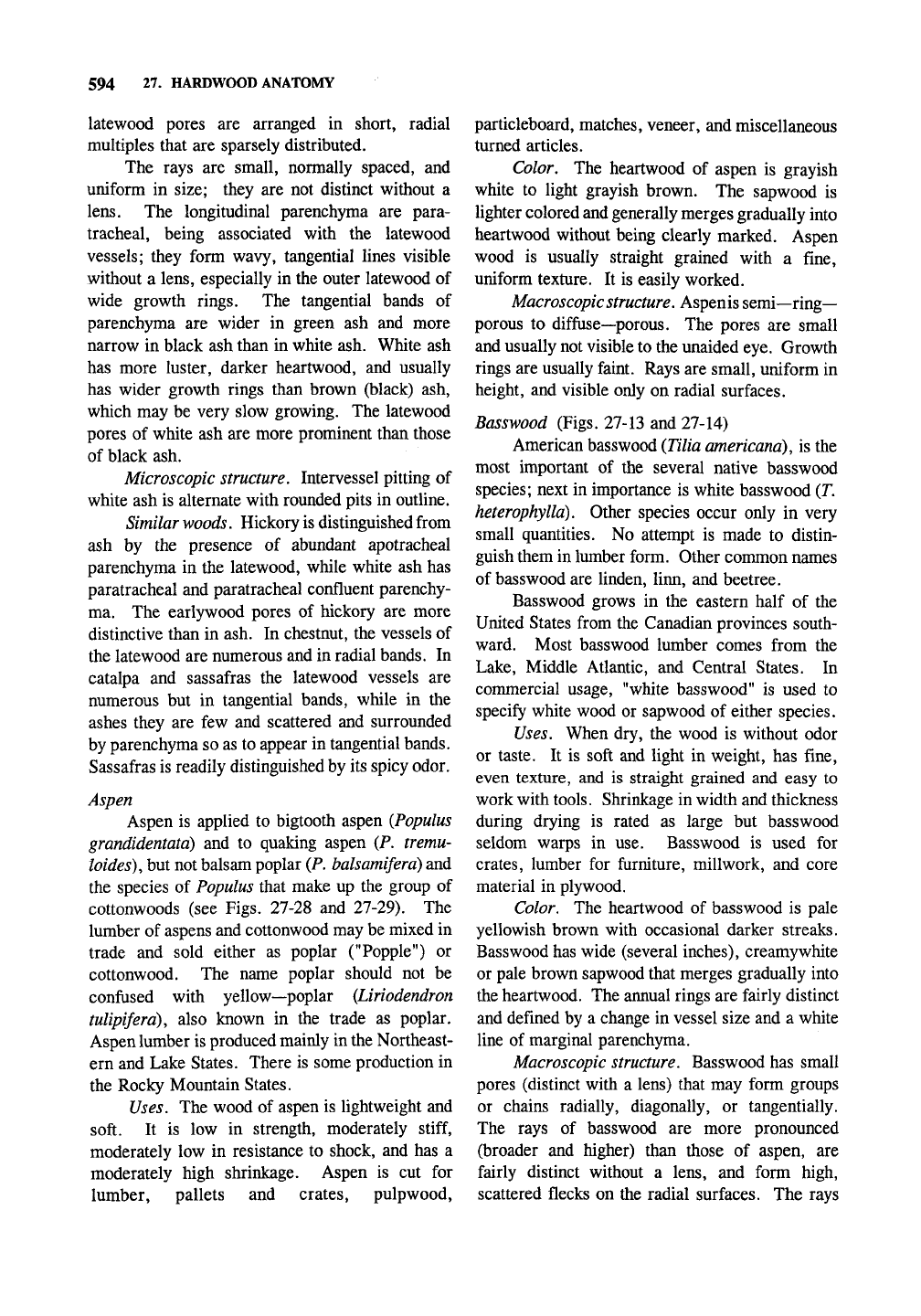
594 27. HARDWOOD ANATOMY
latewood pores are arranged in short, radial
multiples that are sparsely distributed.
The rays are small, normally spaced, and
uniform in size; they are not distinct without a
lens.
The longitudinal parenchyma are para-
tracheal, being associated with the latewood
vessels; they form wavy, tangential lines visible
without a lens, especially in the outer latewood of
wide growth rings. The tangential bands of
parenchyma are wider in green ash and more
narrow in black ash than in white ash. White ash
has more luster, darker heartwood, and usually
has wider growth rings than brown (black) ash,
which may be very slow growing. The latewood
pores of white ash are more prominent than those
of black ash.
Microscopic structure. Intervessel pitting of
white ash is alternate with rounded pits in outline.
Similar
woods.
Hickory is distinguished from
ash by the presence of abundant apotracheal
parenchyma in the latewood, while white ash has
paratracheal and paratracheal confluent parenchy-
ma. The earlywood pores of hickory are more
distinctive than in ash. In chestnut, the vessels of
the latewood are numerous and in radial bands. In
catalpa and sassafras the latewood vessels are
numerous but in tangential bands, while in the
ashes they are few and scattered and surrounded
by parenchyma so as to appear in tangential bands.
Sassafras is readily distinguished by its spicy odor.
Aspen
Aspen is applied to bigtooth aspen {Populus
grandidentata) and to quaking aspen (P. tremu-
toides),
but not balsam poplar
(P.
balsamiferd)
and
the species of Populus that make up the group of
cottonwoods (see Figs. 27-28 and 27-29). The
lumber of aspens and cottonwood may be mixed in
trade and sold either as poplar ("Popple") or
cottonwood. The name poplar should not be
confused with yellow—poplar (Liriodendron
tulipifera),
also known in the trade as poplar.
Aspen lumber is produced mainly in the Northeast-
ern and Lake States. There is some production in
the Rocky Mountain States.
Uses. The wood of aspen is lightweight and
soft. It is low in strength, moderately
stiff,
moderately low in resistance to shock, and has a
moderately high shrinkage. Aspen is cut for
lumber, pallets and crates, pulpwood.
particleboard, matches, veneer, and miscellaneous
turned articles.
Color. The heartwood of aspen is grayish
white to light grayish brown. The sapwood is
lighter colored and generally merges gradually into
heartwood without being clearly marked. Aspen
wood is usually straight grained with a fine,
uniform texture. It is easily worked.
Macroscopic structure. Aspenis semi—ring-
porous to difftise—porous. The pores are small
and usually not visible to the unaided eye. Growth
rings are usually faint. Rays are small, uniform in
height, and visible only on radial surfaces.
Basswood (Figs. 27-13 and 27-14)
American basswood (Tilia americana), is the
most important of the several native basswood
species; next in importance is white basswood (T.
heterophylla). Other species occur only in very
small quantities. No attempt is made to distin-
guish them in lumber form. Other common names
of basswood are linden, linn, and beetree.
Basswood grows in the eastern half of the
United States from the Canadian provinces south-
ward. Most basswood lumber comes from the
Lake, Middle Atlantic, and Central States. In
commercial usage, "white basswood" is used to
specify white wood or sapwood of either species.
Uses. When dry, the wood is without odor
or taste. It is soft and light in weight, has fine,
even texture, and is straight grained and easy to
work with tools. Shrinkage in width and thickness
during drying is rated as large but basswood
seldom warps in use. Basswood is used for
crates,
lumber for furniture, millwork, and core
material in plywood.
Color. The heartwood of basswood is pale
yellowish brown with occasional darker streaks.
Basswood has wide (several inches), creamy white
or pale brown sapwood that merges gradually into
the heartwood. The annual rings are fairly distinct
and defined by a change in vessel size and a white
line of marginal parenchyma.
Macroscopic structure. Basswood has small
pores (distinct with a lens) that may form groups
or chains radially, diagonally, or tangentially.
The rays of basswood are more pronounced
(broader and higher) than those of aspen, are
fairly distinct without a lens, and form high,
scattered flecks on the radial surfaces. The rays
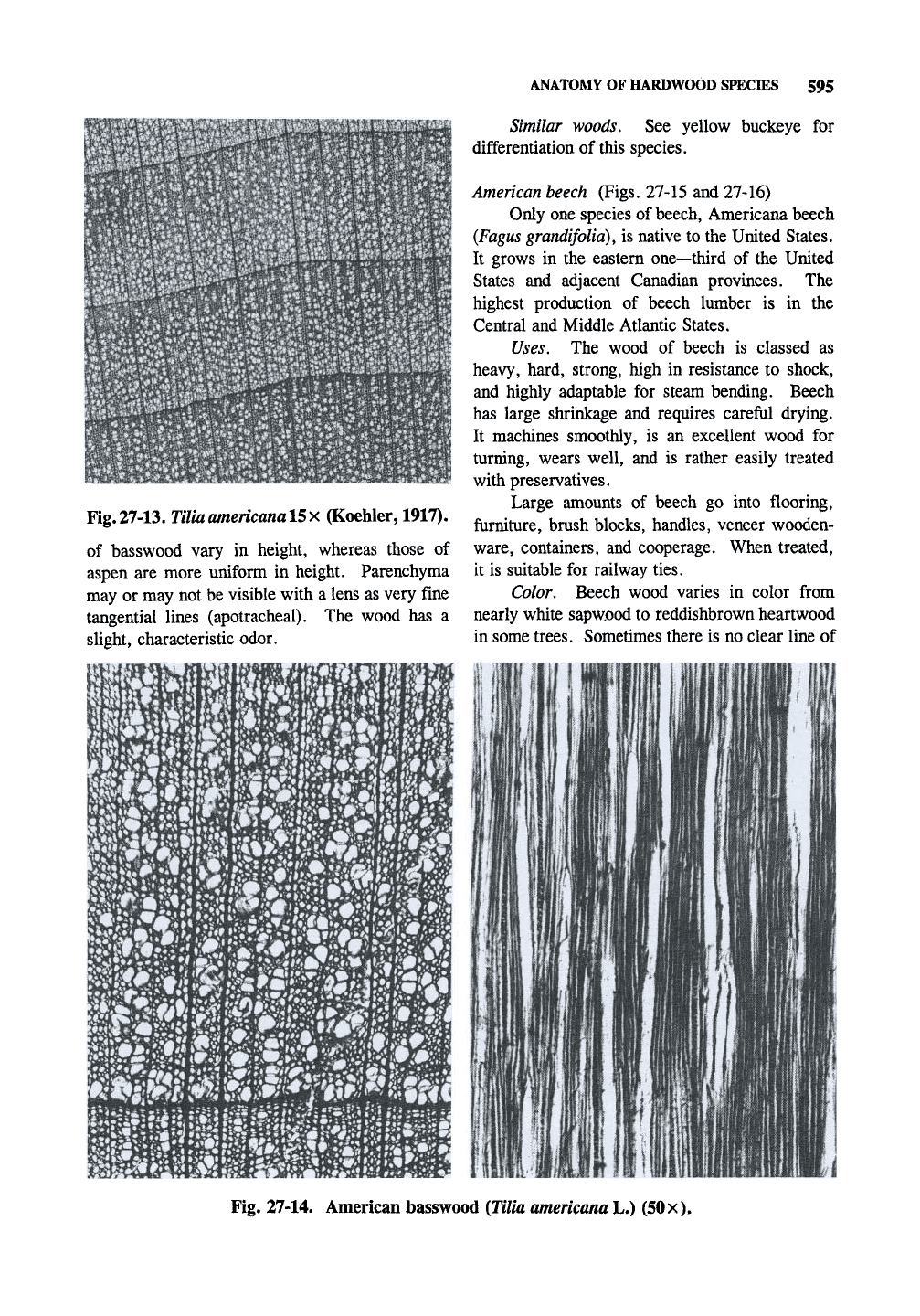
Fig.27-13.
TiliaamericanalSx (Koehler, 1917).
of basswood vary in height, whereas those of
aspen are more uniform in height. Parenchyma
may or may not be visible with a lens as very fine
tangential lines (apotracheal). The wood has a
slight, characteristic odor.
ANATOMY OF HARDWOOD SPECIES 595
Similar woods. See yellow buckeye for
differentiation of this species.
American beech (Figs. 27-15 and 27-16)
Only one species of beech, Americana beech
(Fagus
grandifolia),
is native to the United States,
It grows in the eastern one—third of the United
States and adjacent Canadian provinces. The
highest production of beech lumber is in the
Central and Middle Atlantic States.
Uses. The wood of beech is classed as
heavy, hard, strong, high in resistance to shock,
and highly adaptable for steam bending. Beech
has large shrinkage and requires careftil drying.
It machines smoothly, is an excellent wood for
turning, wears well, and is rather easily treated
with preservatives.
Large amounts of beech go into flooring,
furniture, brush blocks, handles, veneer wooden-
ware, containers, and cooperage. When treated,
it is suitable for railway ties.
Color, Beech wood varies in color from
nearly white sapwood to reddishbrown heartwood
in some trees. Sometimes there is no clear line of
Fig. 27-14. American basswood {Tilia americana L.) (50x).
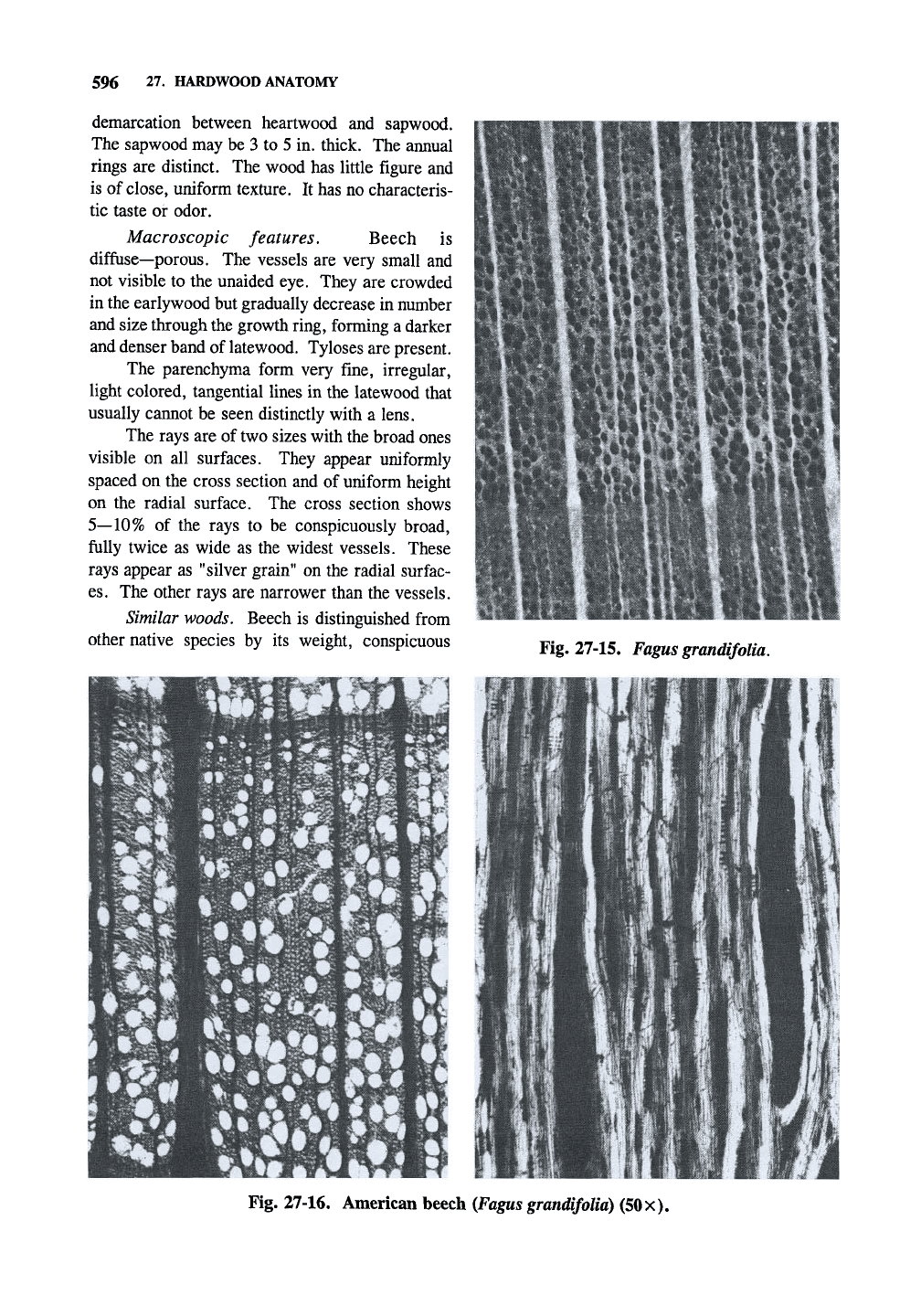
596 27. HARDWOOD ANATOMY
demarcation between heartwood and sapwood.
The sapwood may be 3 to 5 in. thick. The annual
rings are distinct. The wood has little figure and
is of
close,
uniform texture. It has no characteris-
tic taste or odor.
Macroscopic features. Beech is
diffuse—porous. The vessels are very small and
not visible to the unaided eye. They are crowded
in the earlywood but gradually decrease in number
and size through the growth ring, forming a darker
and denser band of latewood. Tyloses are present.
The parenchyma form very fine, irregular,
light colored, tangential lines in the latewood that
usually cannot be seen distinctly with a lens.
The rays are of two sizes with the broad ones
visible on all surfaces. They appear uniformly
spaced on the cross section and of uniform height
on the radial surface. The cross section shows
5—10% of the rays to be conspicuously broad,
fully twice as wide as the widest vessels. These
rays appear as "silver grain" on the radial surfac-
es.
The other rays are narrower than the vessels.
Similar woods. Beech is distinguished from
other native species by its weight, conspicuous
Fig. 27-15.
Fagus
grandifolia.
Fig. 27-16. American beech
{Fagus grandifolia)
(50x).
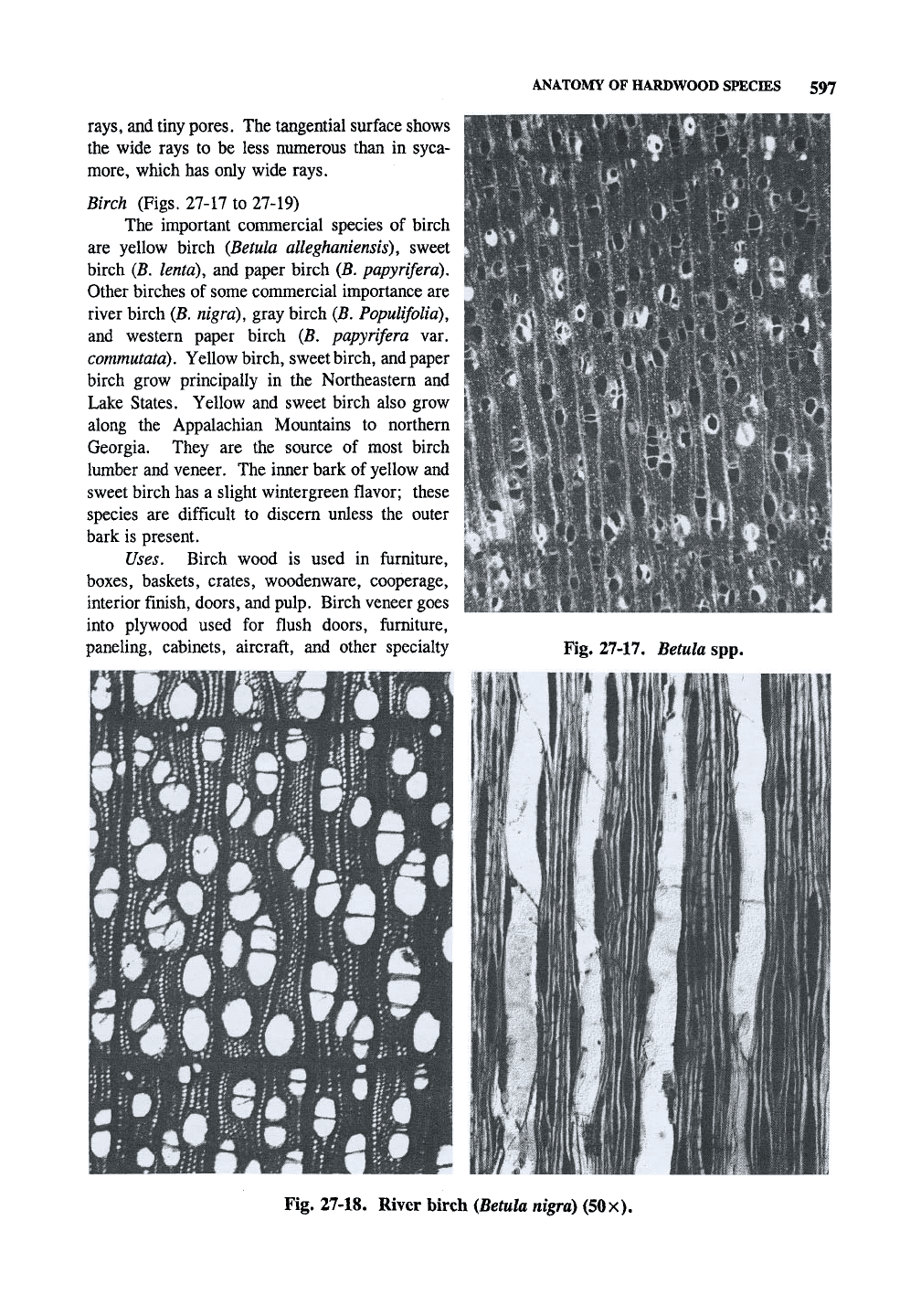
ANATOMY OF HARDWOOD SPECIES 597
rays,
and tiny pores. The tangential surface shows
the wide rays to be less numerous than in syca-
more, which has only wide rays.
Birch (Figs. 27-17 to 27-19)
The important commercial species of birch
are yellow birch {Betula alleghaniensis), sweet
birch (B. lento), and paper birch (B. papyrifera).
Other birches of some commercial importance are
river birch
{B.
nigra), gray birch
{B.
Populifolia),
and western paper birch {B, papyrifera var.
commutata). Yellow birch, sweet birch, and paper
birch grow principally in the Northeastern and
Lake States. Yellow and sweet birch also grow
along the Appalachian Mountains to northern
Georgia. They are the source of most birch
lumber and veneer. The inner bark of yellow and
sweet birch has a slight wintergreen flavor; these
species are difficult to discern unless the outer
bark is present.
Uses. Birch wood is used in furniture,
boxes,
baskets, crates, woodenware, cooperage,
interior finish, doors, and pulp. Birch veneer goes
into plywood used for flush doors, furniture,
paneling, cabinets, aircraft, and other specialty
Fig. 27-17. Betula spp.
Fig. 27-18. River birch (Betula nigra) (50x).
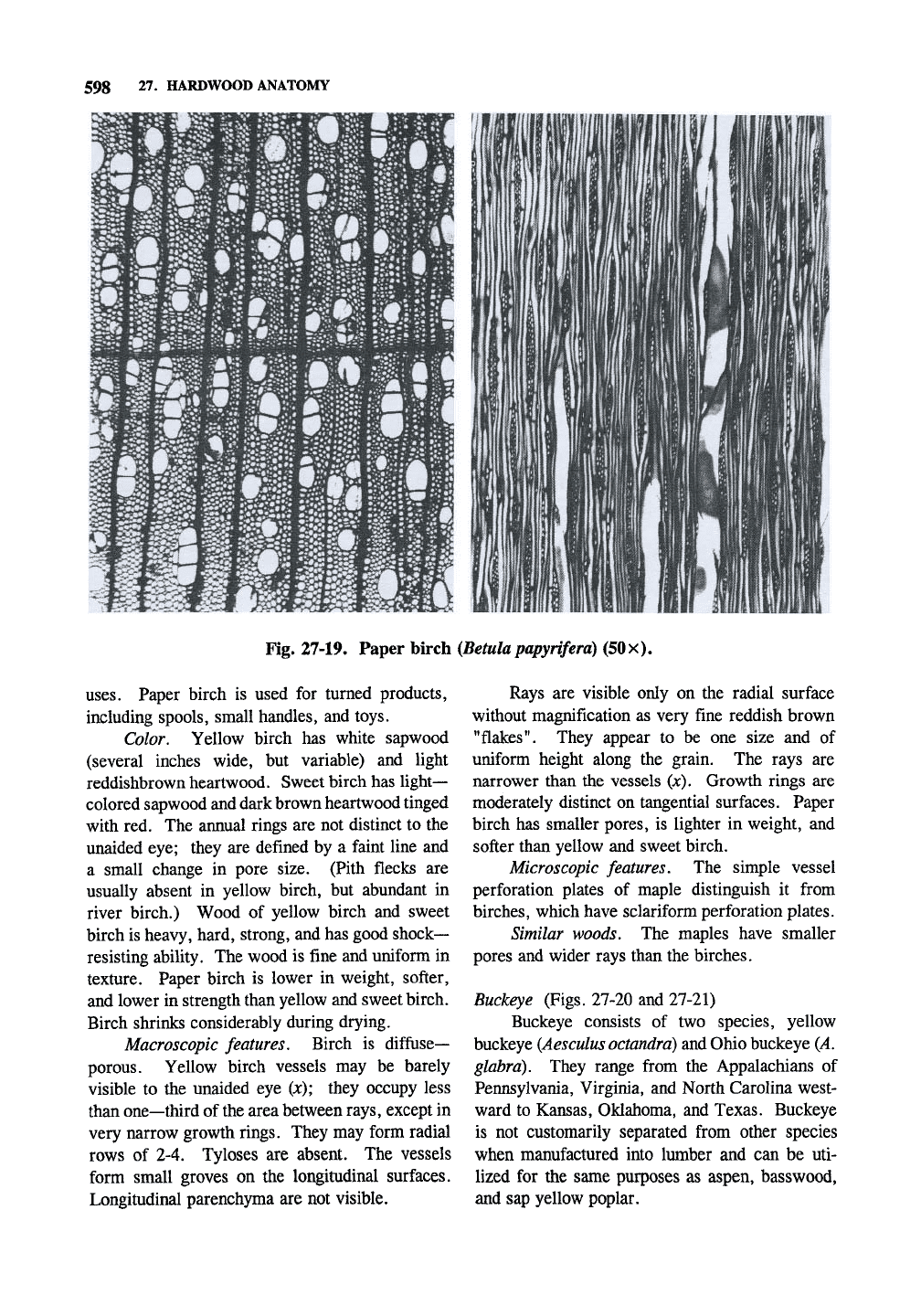
598
27.
HARDWOOD ANATOMY
Fig. 27-19. Paper birch
(Betula papyrifera)
(50x).
uses.
Paper birch is used for turned products,
including spools, small handles, and toys.
Color. Yellow birch has white sapwood
(several inches wide, but variable) and light
reddishbrown heartwood. Sweet birch has light-
colored sapwood and dark brown heartwood tinged
with red. The annual rings are not distinct to the
unaided eye; they are defined by a faint line and
a small change in pore size. (Pith flecks are
usually absent in yellow birch, but abundant in
river birch.) Wood of yellow birch and sweet
birch is heavy, hard, strong, and has good shock-
resisting ability. The wood is fine and uniform in
texture. Paper birch is lower in weight, softer,
and lower in strength than yellow and sweet birch.
Birch shrinks considerably during drying.
Macroscopic features. Birch is diffuse-
porous. Yellow birch vessels may be barely
visible to the unaided eye (x); they occupy less
than one—third of
the
area between rays, except in
very narrow growth rings. They may form radial
rows of 2-4. Tyloses are absent. The vessels
form small groves on the longitudinal surfaces.
Longitudinal parenchyma are not visible.
Rays are visible only on the radial surface
without magnification as very fine reddish brown
"flakes". They appear to be one size and of
uniform height along the grain. The rays are
narrower than the vessels (x). Growth rings are
moderately distinct on tangential surfaces. Paper
birch has smaller pores, is lighter in weight, and
softer than yellow and sweet birch.
Microscopic features. The simple vessel
perforation plates of maple distinguish it from
birches, which have sclariform perforation plates.
Similar woods. The maples have smaller
pores and wider rays than the birches.
Buckeye (Figs. 27-20 and 27-21)
Buckeye consists of two species, yellow
buckeye
(Aesculus octandra)
and Ohio buckeye {A.
glabra).
They range from the Appalachians of
Pennsylvania, Virginia, and North Carolina west-
ward to Kansas, Oklahoma, and Texas. Buckeye
is not customarily separated from other species
when manufactured into lumber and can be uti-
lized for the same purposes as aspen, basswood,
and sap yellow poplar.

ANATOMY OF HARDWOOD SPECDES 599
Uses. The wood is uniform in texture,
usually straight—grained, light in weight, weak in
beam use, soft, and low in shock resistance. It is
rated low on machinability such as shaping, steam
bending, boring, and turning. Buckeye is suitable
for pulping for paper; its lumber is used princi-
pally for ftirniture, crates, food containers, wood-
enware, novelties, and planning mill products.
Color. The white sapwood of buckeye
merges gradually into the creamy or yellowish
white heartwood. The annual rings are not always
distinct and are defined by light—colored lines of
marginal parenchyma.
Macroscopic features. The pores are very
small, uniform in size, and distributed evenly
throughout the growth ring (diffuse—porous). The
rays are very fine (uniseriate), even imder a lens.
They are storied (arranged in tiers), producing
very fine bands or ripple marks running across the
tangential surface (not as pronounced 'mA. glabra^
but made more visible by wetting its surface).
Marginal parenchyma are seen with a lens.
Similar woods. Basswood is differentiated
from buckeye by the conspicuous rays of bass-
Fig.
21'2^,Aesculus
octandra
15 X (Koehler, 1917).
wood. The fine lines of buckeye on the tangential
surface also distinguish it from basswood.
Butternut (Figs. 27-22 and 27-23)
Butternut (Juglans cinerea) is also called
Fig.
27-21.
Yellow buckeye {Aesculus
octandra)
(50x).
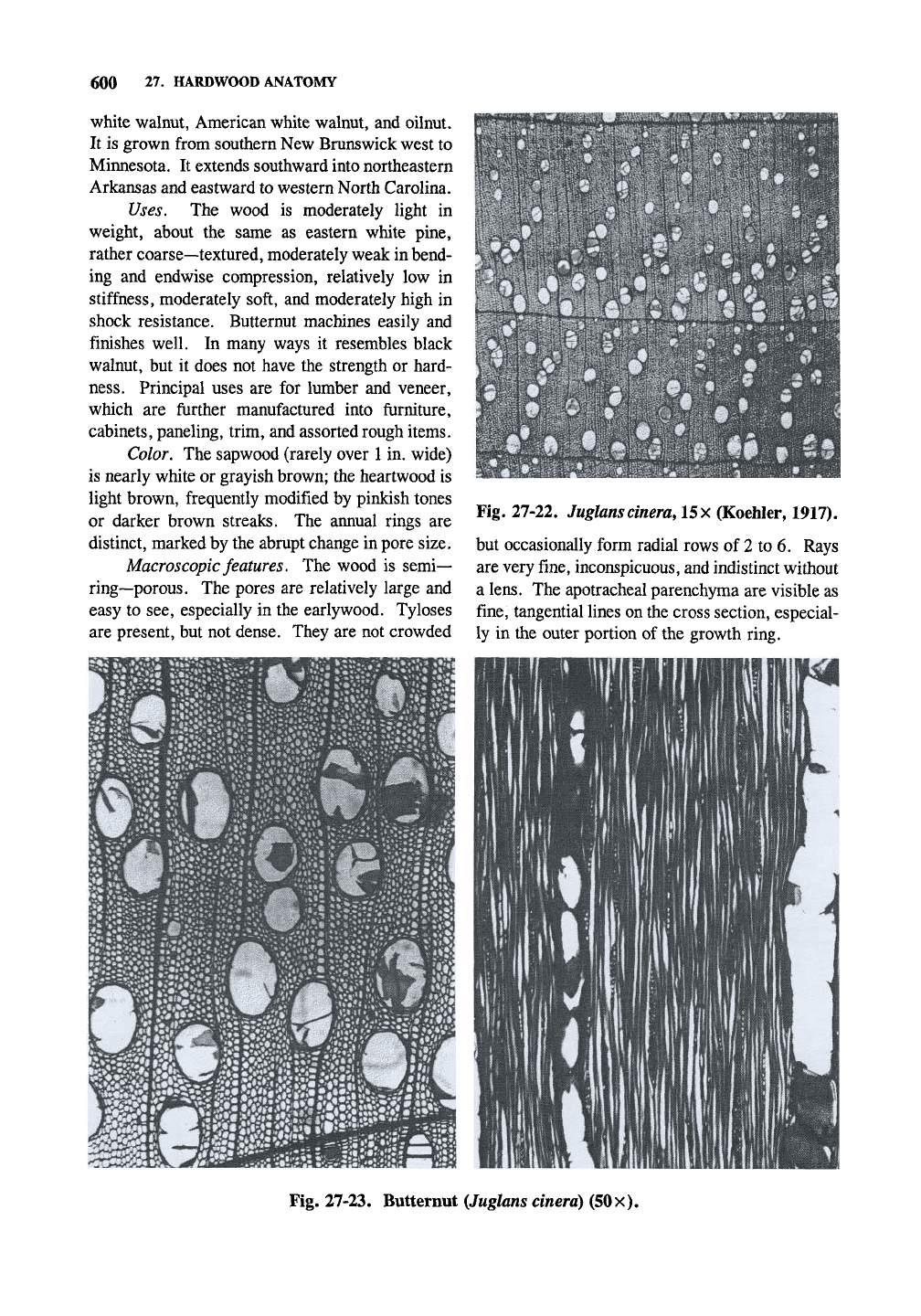
600 27. HARDWOOD ANATOMY
white walnut, American white walnut, and oilnut.
It is grown from southern New Brunswick west to
Minnesota. It extends southward into northeastern
Arkansas and eastward to western North Carolina.
Uses. The wood is moderately light in
weight, about the same as eastern white pine,
rather coarse—textured, moderately weak in bend-
ing and endwise compression, relatively low in
stiffness, moderately soft, and moderately high in
shock resistance. Butternut machines easily and
finishes well. In many ways it resembles black
walnut, but it does not have the strength or hard-
ness.
Principal uses are for lumber and veneer,
which are further manufactured into furniture,
cabinets, paneling, trim, and assorted rough items.
Color. The sapwood (rarely over
1
in. wide)
is nearly white or grayish brown; the heartwood is
light brown, frequently modified by pinkish tones
or darker brown streaks. The annual rings are
distinct, marked by the abrupt change in pore size.
Macroscopic
features. The wood is semi-
ring—porous. The pores are relatively large and
easy to see, especially in the early wood. Tyloses
are present, but not dense. They are not crowded
Fig. 27-22. Juglanscinera, 15x (Koehler, 1917).
but occasionally form radial rows of 2 to 6. Rays
are very fine, inconspicuous, and indistinct without
a lens. The apotracheal parenchyma are visible as
fine,
tangential lines on the cross section, especial-
ly in the outer portion of the growth ring.
Fig. 27-23. Butternut
{Juglans
cinera) (50x).
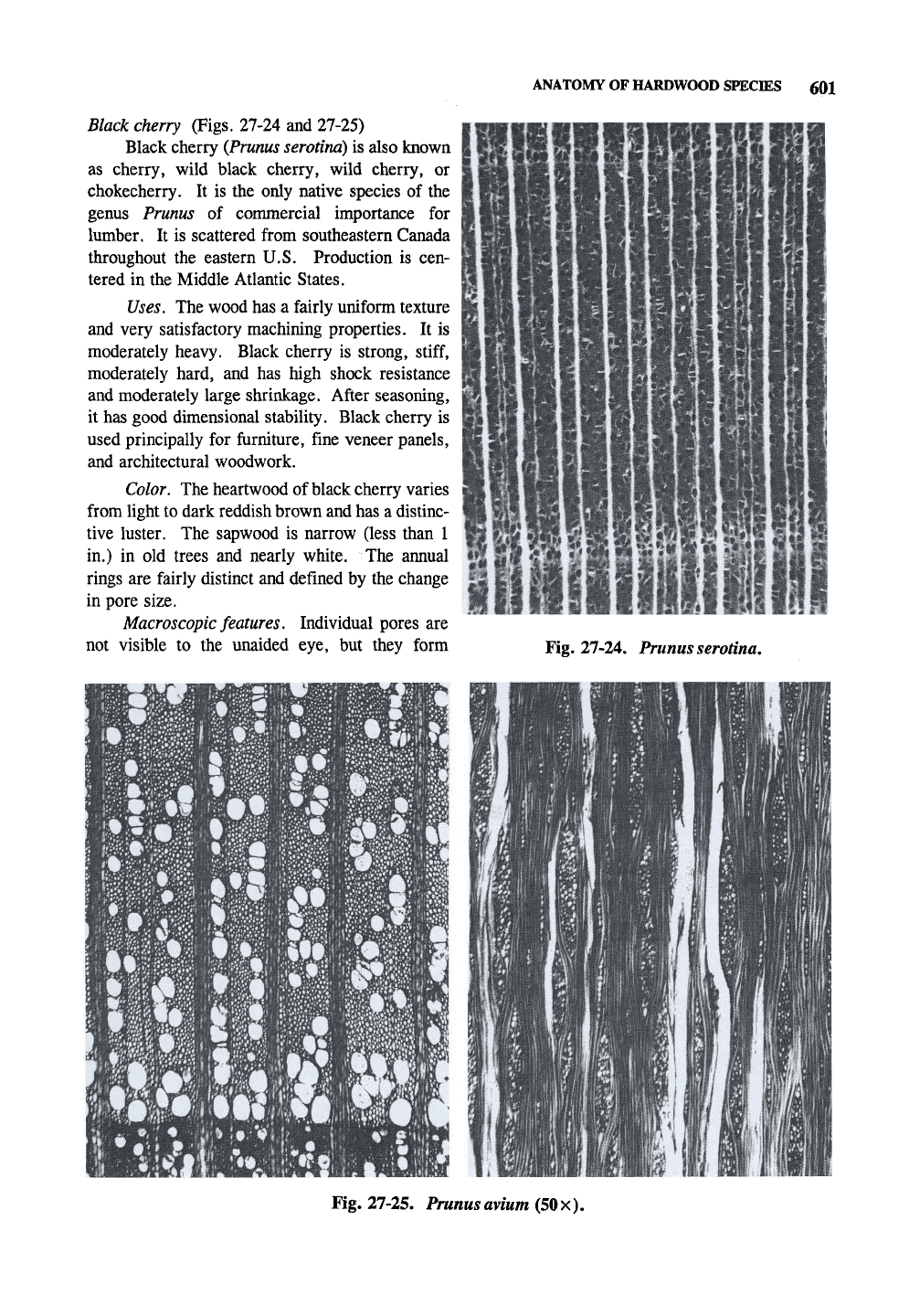
ANATOMY OF HARDWOOD SPECIES 601
Black cherry (Figs. 27-24 and 27-25)
Black cherry
(Prunus serotina)
is also known
as cherry, wild black cherry, wild cherry, or
chokecherry. It is the only native species of the
genus Prunus of commercial importance for
lumber. It is scattered from southeastern Canada
throughout the eastern U.S. Production is cen-
tered in the Middle Atlantic States.
Uses. The wood has a fairly uniform texture
and very satisfactory machining properties. It is
moderately heavy. Black cherry is strong,
stiff,
moderately hard, and has high shock resistance
and moderately large shrinkage. After seasoning,
it has good dimensional stability. Black cherry is
used principally for furniture, fine veneer panels,
and architectural woodwork.
Color. The heartwood of black cherry varies
from light to dark reddish brown and has a distinc-
tive luster. The sapwood is narrow (less than 1
in.) in old trees and nearly white. The annual
rings are fairly distinct and defined by the change
in pore size.
Macroscopic features. Individual pores are
not visible to the unaided eye, but they form
Fig. 27-24. Prunus serotina.
Fig. 27-25.
Prunus avium
(50
X).
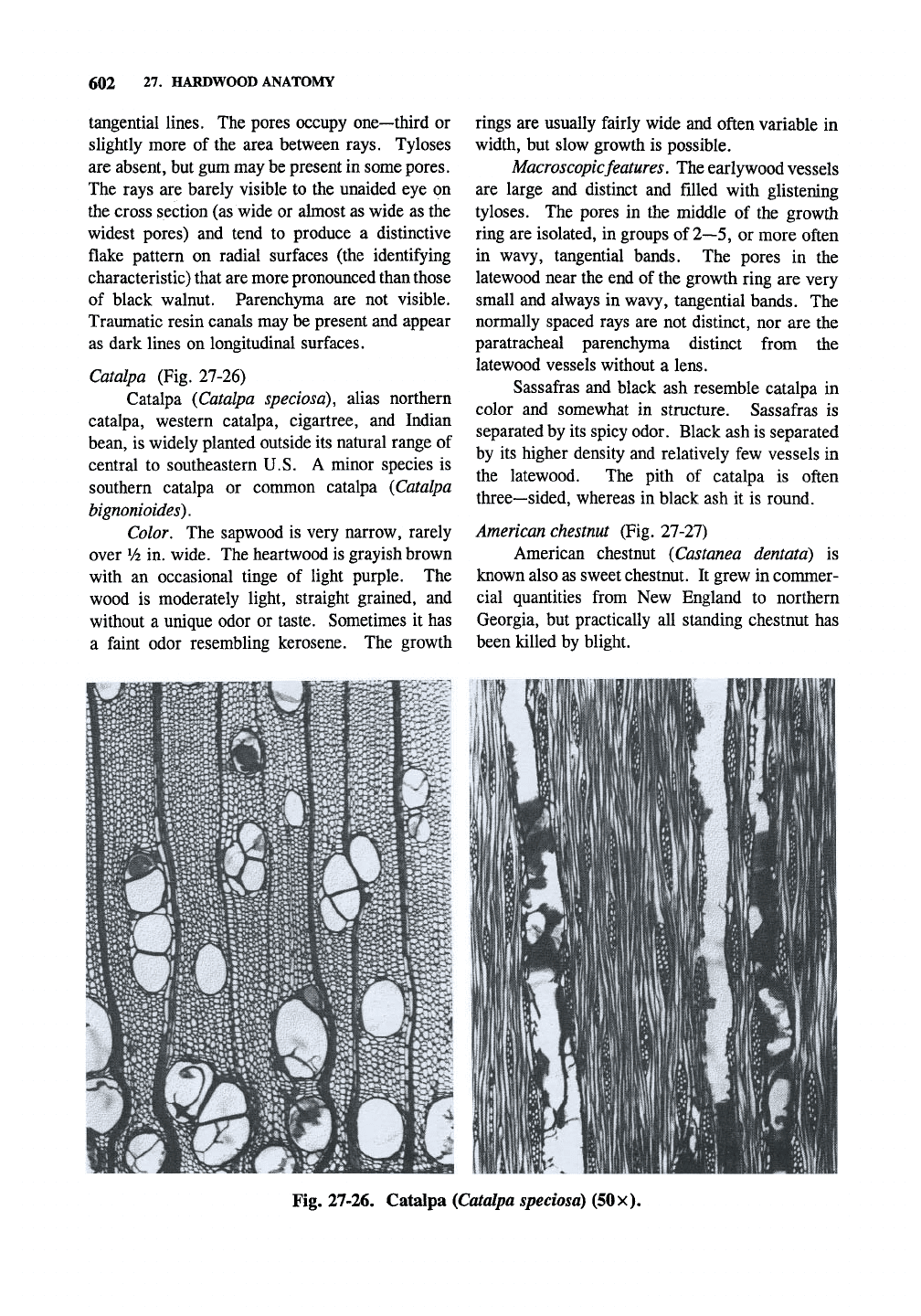
602 27. HARDWOOD ANATOMY
tangential lines. The pores occupy one—third or
slightly more of the area between rays. Tyloses
are absent, but gum may be present in some pores.
The rays are barely visible to the unaided eye on
the cross section (as wide or almost as wide as the
widest pores) and tend to produce a distinctive
flake pattern on radial surfaces (the identifying
characteristic) that are more pronounced than those
of black walnut. Parenchyma are not visible.
Traumatic resin canals may be present and appear
as dark lines on longitudinal surfaces.
Catalpa (Fig. 27-26)
Catalpa {Catalpa speciosa), alias northern
catalpa, western catalpa, cigartree, and Indian
bean, is widely planted outside its natural range of
central to southeastern U.S. A minor species is
southern catalpa or common catalpa (Catalpa
bignonioides).
Color. The sapwood is very narrow, rarely
over Vi in. wide. The heartwood is grayish brown
with an occasional tinge of light purple. The
wood is moderately light, straight grained, and
without a unique odor or taste. Sometimes it has
a faint odor resembling kerosene. The growth
rings are usually fairly wide and often variable in
width, but slow growth is possible.
Macroscopic features. The early wood vessels
are large and distinct and filled with glistening
tyloses. The pores in the middle of the growth
ring are isolated, in groups of
2—5,
or more often
in wavy, tangential bands. The pores in the
latewood near the end of the growth ring are very
small and always in wavy, tangential bands. The
normally spaced rays are not distinct, nor are the
paratracheal parenchyma distinct from the
latewood vessels without a lens.
Sassafras and black ash resemble catalpa in
color and somewhat in structure. Sassafras is
separated by its spicy odor. Black ash is separated
by its higher density and relatively few vessels in
the latewood. The pith of catalpa is often
three—sided, whereas in black ash it is round.
American chestnut (Fig. 27-27)
American chestnut (Castanea dentatd) is
known also as sweet chestnut. It grew in commer-
cial quantities from New England to northern
Georgia, but practically all standing chestnut has
been killed by blight.
Fig. 27-26. Catalpa
{Catalpa
speciosa)
(50
x).
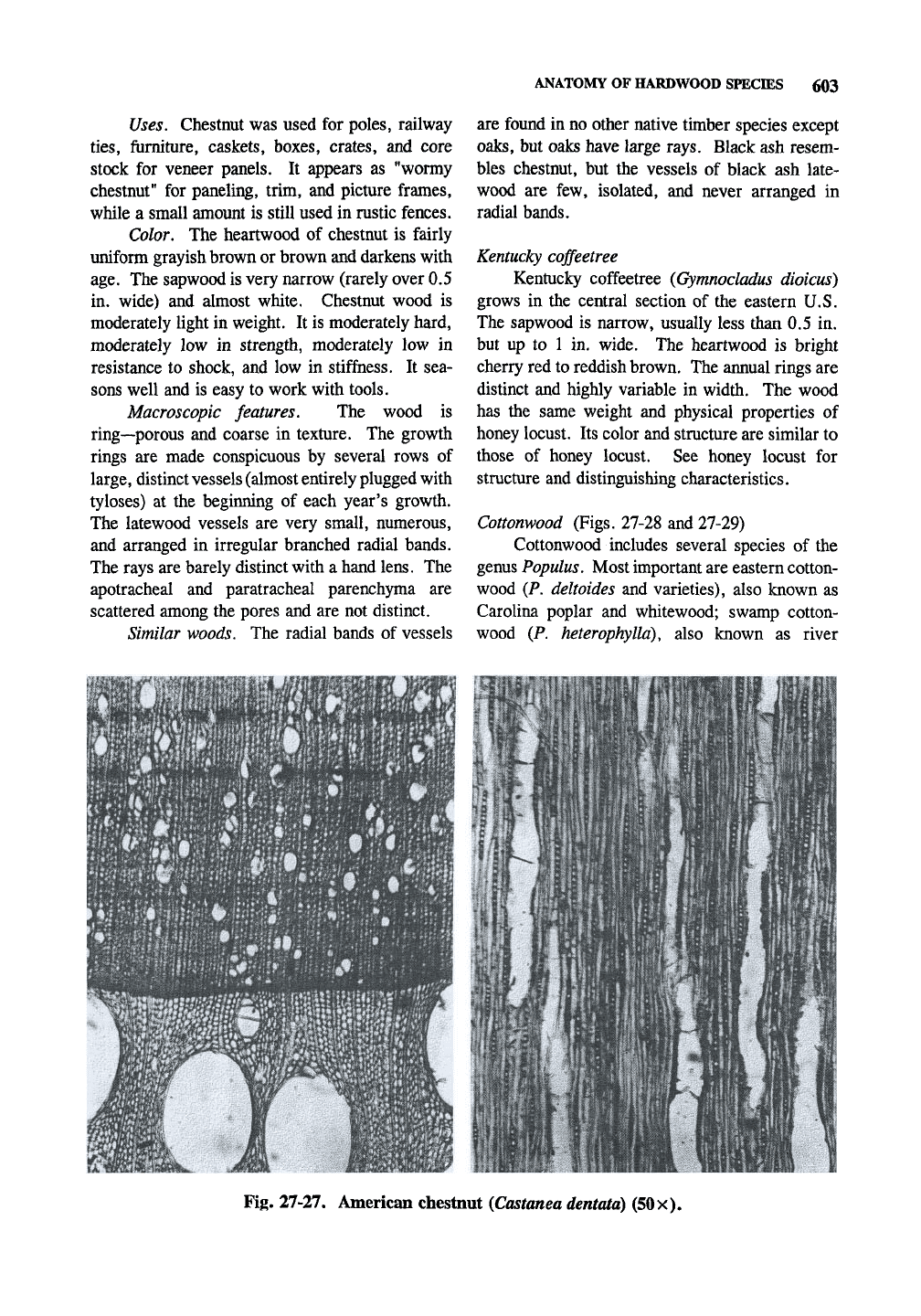
ANATOMY OF HARDWOOD SPECIES 603
Uses, Chestnut was used for poles, railway
ties,
furniture, caskets, boxes, crates, and core
stock for veneer panels. It appears as "wormy
chestnut" for paneling, trim, and picture frames,
while a small amount is still used in rustic fences.
Color, The heartwood of chestnut is fairly
uniform grayish brown or brown and darkens with
age.
The sapwood is very narrow (rarely over 0.5
in. wide) and almost white. Chestnut wood is
moderately light in weight. It is moderately hard,
moderately low in strength, moderately low in
resistance to shock, and low in stiffness. It sea-
sons well and is easy to work with tools.
Macroscopic features. The wood is
ring—porous and coarse in texture. The growth
rings are made conspicuous by several rows of
large, distinct vessels (almost entirely plugged with
tyloses) at the beginning of each year's growth.
The latewood vessels are very small, numerous,
and arranged in irregular branched radial bands.
The rays are barely distinct with a hand lens. The
apotracheal and paratracheal parenchyma are
scattered among the pores and are not distinct.
Similar woods. The radial bands of vessels
are found in no other native timber species except
oaks,
but oaks have large rays. Black ash resem-
bles chestnut, but the vessels of black ash late-
wood are few, isolated, and never arranged in
radial bands.
Kentucky coffeetree
Kentucky coffeetree {Gymnocladus dioicus)
grows in the central section of the eastern U.S.
The sapwood is narrow, usually less than 0.5 in.
but up to 1 in. wide. The heartwood is bright
cherry red to reddish brown. The annual rings are
distinct and highly variable in width. The wood
has the same weight and physical properties of
honey locust. Its color and structure are similar to
those of honey locust. See honey locust for
structure and distinguishing characteristics.
Cottonwood (Figs. 27-28 and 27-29)
Cottonwood includes several species of the
genus
Populus.
Most important are eastern cotton-
wood {P. deltoides and varieties), also known as
Carolina poplar and whitewood; swamp cotton-
wood (P. heterophylla), also known as river
Fig. 27-27. American chestnut
(Castanea dentata)
(50x).
